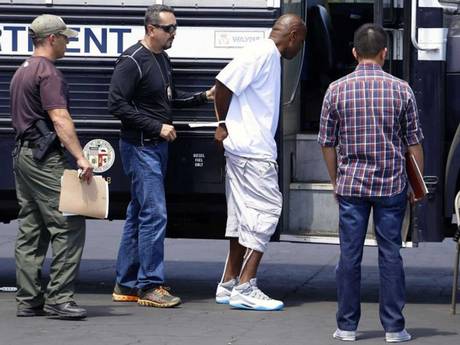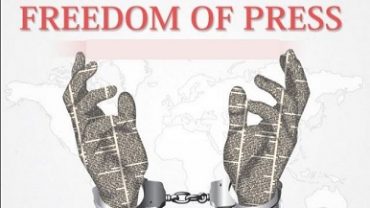Gang dragnet sweeps up 72 of LA’s hard-core Crips
For more than two decades, a street gang known as the Five Deuce Broadway Gangster Crips has terrorised the territory it calls its own in South Central Los Angeles, while profiting from the sale of drugs to vulnerable, homeless addicts in the city’s blighted Skid Row district. But this week, 50 suspected members – almost one third of the entire gang – found themselves behind bars following a major bust by the FBI and LAPD.
The arrests came early on Tuesday, as 1,300 law enforcement officers swooped on suspects’ homes and properties, making arrests and seizing weapons and drugs including cocaine, crack cocaine, methamphetamine and marijuana. The Five Deuce gang originated in the neighbourhood around the corner of Broadway and 52nd Street, south of Downtown, but its drug trafficking activities are thought to stretch as far afield as Louisiana and Minnesota.
The police sweep was named Operation “Gremlin Riderz”, after the ultra-violent clique that comprises the majority of the suspects, whose nicknames reportedly include “Baby Too Cool” and “Tiny C-Bone”. There are 72 defendants named in a federal racketeering indictment detailing the gang’s alleged involvement in more than 100 crimes including murder, robbery and extortion stretching back to the 1980s. All those named face at least 10 years in prison if they are convicted.
 Some of the weapons seized The Five Deuce are accused of four murders since 1987, including the 2012 shooting of an unarmed man with no gang affiliations. A 10-year-old girl was shot in the same incident. The gang is also believed to have targeted bank customers, following them home from their withdrawals to rob them at gunpoint. According to the indictment, they opened accounts and rented properties and vehicles using the names of female friends and relatives, because they drew less attention.
Some of the weapons seized The Five Deuce are accused of four murders since 1987, including the 2012 shooting of an unarmed man with no gang affiliations. A 10-year-old girl was shot in the same incident. The gang is also believed to have targeted bank customers, following them home from their withdrawals to rob them at gunpoint. According to the indictment, they opened accounts and rented properties and vehicles using the names of female friends and relatives, because they drew less attention.
The majority of LA street gangs are Latino, but no Latino gang has achieved the worldwide notoriety of the overwhelmingly African-American Crips and their bitter rivals, the Bloods. The Crips were founded in 1969, while the Bloods formed from a breakaway faction shortly thereafter. When the crack cocaine epidemic spread to LA in the early 1980s, the two fought viciously for control of the market. They became known globally due to their pop cultural depiction in movies and rap lyrics, famously identifying themselves by wearing gang colours: blue for Crips, red for Bloods.
Today, the city’s murder rate is a quarter of what it was in 1980. Violent crime has plummeted thanks to economic improvements, smart policing and community gang intervention programmes. The Crips and the Bloods, meanwhile, have devolved into a broad and varied selection of small, barely connected street gangs. “Those two monolithic gangs and their rivalry are long over,” said Jorja Leap, a gangs expert and professor at UCLA’s Luskin School of Public Affairs.
 Other members of the gang caught “There is no single structure, no president of the corporation. The original gangsters often shake their heads and tell me the youngsters have no respect for the past, they’re operating independently, they don’t observe the rules. These groups may still carry the Crips name, but they’re in no way associated with the gang as it was originally constituted.”
Other members of the gang caught “There is no single structure, no president of the corporation. The original gangsters often shake their heads and tell me the youngsters have no respect for the past, they’re operating independently, they don’t observe the rules. These groups may still carry the Crips name, but they’re in no way associated with the gang as it was originally constituted.”
The Five Deuce originally formed as one of multiple Crips sub-groups during the 1970s, but today the gang’s continued brutality marks it out as part of the minority. “There’s only a small percentage of black gangs that are still just brutally violent, and [the Five Deuce Broadway Gangster Crips] is one of them,” Professor Leap said. “They are exceptionally and consistently violent. They’re also unusually disciplined compared to most black gangs in LA.”
Following the arrests this week, US Attorney André Birotte said the most “insidious” aspect of the gang’s activities was its “exploitation of Skid Row drug users who are already living in difficult circumstances.” Though much of Downtown LA is fast becoming gentrified, the few square blocks known as Skid Row are still marred to a shocking extent by homelessness, drug abuse and crime. To those who never venture into the neighbourhood, this week’s news served as a reminder that some of the old Los Angeles remains.
